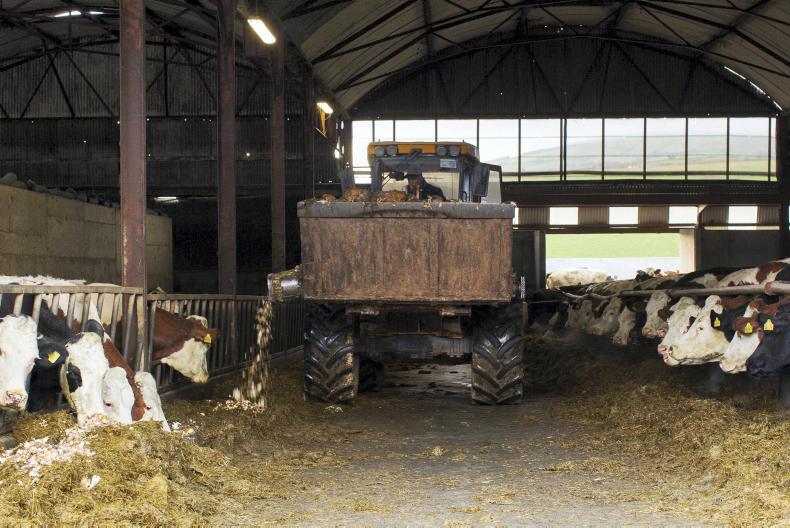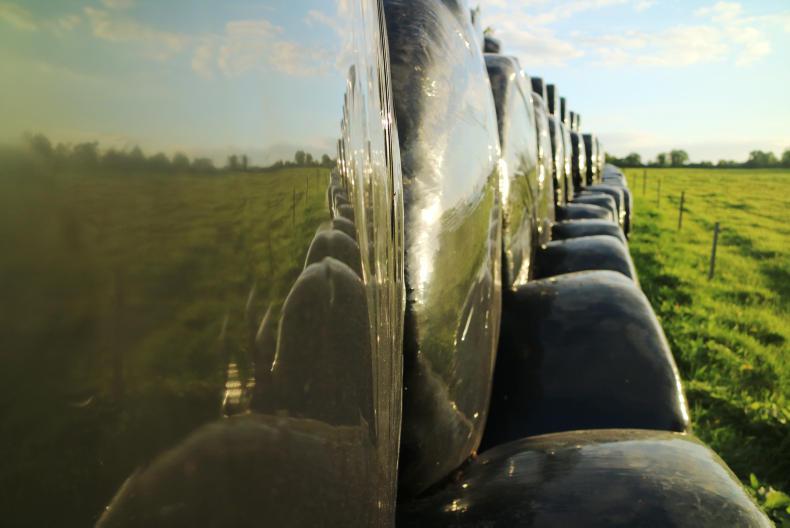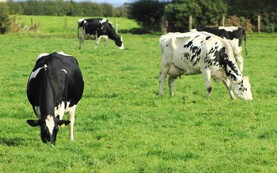Toward the end of the summer, once the main silage cuts had been taken, we encouraged producers to carry out a winter silage budget.
While it may have seemed premature at that point, it gave farmers sufficient time to react to potential deficits.
There was still time to be more ruthless when taking out surplus grass or indeed to consider out-wintering crop options.
For some, circumstances have changed.
Concentrated downpours in recent weeks have led to deplorable ground conditions and an inevitable move indoors for many of the country’s cattle. While the weather in recent days has been kinder, the reality is that winter is in for many – there will be no return to grass.
Budget again
Even if there seems to be mountains of silage saved, do a budget. They’re quick and painless. Those whose winter has begun prematurely shouldn’t need a second thought. Keeping 30 cows indoors for an extra fortnight requires 21t of fresh silage.
When we consider that a good yield from first-cut silage is 9t per acre, it is easy to see how stocks can deplete fast. A guide to silage budgeting can be found on our YouTube channel or in our Feed Guide, both flagged below.
Stretch my silage
So you’re showing up a deficit – what next? Obviously there is no chance of taking extra bales or establishing out-wintering crops at this point in the year. And, we can assume that selling stock off is not an option.
Any extra fodder must be purchased at this point. Table 1 outlines the common options that will be available to Irish farmers this winter for replacing fodder.
What to look for in a feed
Typically, paying extra for a feed rich in nutrients makes better economic sense than paying pittance for a feed with moderate nutrient quality. Shirking on quality with animal diets will depress production, potentially affect their well-being and ultimately hit our wallets.
In Table 1, feeds are costed on an energy basis at current prices relative to rolled barley. Good-quality silage remains the cheapest winter fodder source we have – its energy is cheaper than that of barley and it requires no additional supplementation in many cases.
Winter feeding regimes based on beet, maize silage or hay might seem quite cheap, but we are not taking into account the extra feeds that must be purchased in addition to these ingredients as balancers: all of these options need supplementary protein – the most expensive nutrient for livestock – with barley needing a long fibre source too.
Silage – friend and foe
A big downside to grass silage is that, in terms of quality, it is probably the most variable ingredient in Table 1. Silage is very seldom tested when we go to purchase too – we rely on the seller’s word.
Yet, animal performance from the poor-quality silage costs us 17% more (€0.91 versus €1.07) than performance from the good-quality silage. This is before we purchase the extra energy and protein supplements that are required to maintain performance.
When purchasing silage, getting some sort of handle on its feed value is a must.
Pat
Farmer, Co Kerry
Pat Farmer normally requires winter feeding for five months (1 November to 1 April). However, record rainfall in the area saturated his land and forced all stock indoors last week, one month ahead of schedule.
He has 470t of silage saved and has 25 suckler cows, their spring-born weanling calves (350kg) and 25 store cattle (520kgs) to feed.
His fodder requirement for the winter is 511t. In a normal five-month winter, he would need 426t. Housing one month earlier has left him with a small deficit – which may be a common situation this year.
Key points: silage deficit
25-cow suckler farm in Kerry.Gone from potential surplus to deficit after housing early.Needs to buy in fodder.Option 1: Buy in silage
This seems like the most logical thing for Pat to do. Yet, he is leaving himself open to being stung, given the variability of grass silage. Pat should ask to see a silage test from any potential seller, or come to an agreement that there will be no deal if the analysis comes back below expectations. Suckler cows hitting the house now in optimum body condition require 46kg of 65% DMD silage daily for the winter. Pat needs to purchase 80 round bales (65 if wilted for 24 hours) to feed his dry cows.
Additional cost: €1,600Pros: Bales easily handled. No additional supplements necessary.Con: Variable quality – test crucial.Option 2: Finish stores
Continental store cattle will be eating around 43kg of silage daily (plus ~1kg of meals depending on quality).
One option for Pat is to finish these cattle, slaughtering early in 2017.
While it may scupper his 2017 grazing plans, there will be cash available to replace these animals when they are slaughtered if he sees fit. Finishing these animals on 6kg of meal (€240/t) plus silage for 120 days (shorter period for lesser-quality animals) will see a 365kg carcase produced.
This will wipe 65t (two months’ worth) from the end of the fodder requirement and 48t less silage will be required during the finishing phase as concentrates make up just over half the diet (after gradual adaption).
Additional cost: €4,320Pros: Pressure on cashflow will be short-term. Slaughtering animals after 120 days. Silage war chest built up.Con: May not have facility to store meals.Option 3: Fodder beet
Fodder beet is an excellent feed for cattle and many nutritionists will say that it punches above its weight. The feed is so palatable that cattle will continue eating even after they fill up, driving performance.
I would actually earmark fodder beet for Pat’s cows in this instance. It typically needs to be balanced with a protein source, but if we assume that Pat’s silage is quite high in crude protein (14%), we can get away without having to purchase any supplementary protein for cows.

If we were to gear fodder beet towards any of Pat’s other stock, protein would be required as they are still growing.
Assuming a wintering dry cow would normally get 46kg of silage (restricted) daily, we could replace 10kg of this with 7.5kg of fodder beet for the complete winter.
This would act to free up 45.6t of silage, leaving us with a 15t silage surplus. Remember to introduce dry cow minerals in the months prior to calving. Also, where heifers are calving at two years, offer 150g of soya bean meal per head to first calvers as an insurance policy. Let’s assume Pat has five first-calvers – they’ll require €56 worth of soya bean meal.
Additional cost: €1,492.Pro: Relatively cheap option.Cons: Requires washing and chopping. Wet feed, difficult to store.Option 4: Straw and barley

With barley competitively priced at present, a straw-barley combination may be the answer to Pat’s problems.
In the case of his dry cows, Pat could replace 10kg of grass silage with 2kg of straw and 1kg of rolled barley daily, while still getting the same amount of energy and protein into the diet.
This would free up 45.6t of grass silage, bringing his fodder requirement back from 511t to 465t and resulting in a 5t surplus.
Additional cost: €1,528.Pro: Relatively cheap option.Cons: Feed storage. Read more
Meal time: what's on the menu for beef cattle this winter?
What can my silage do for me this winter?
How far will my silage go this winter?
Focus: Winter feed
Toward the end of the summer, once the main silage cuts had been taken, we encouraged producers to carry out a winter silage budget.
While it may have seemed premature at that point, it gave farmers sufficient time to react to potential deficits.
There was still time to be more ruthless when taking out surplus grass or indeed to consider out-wintering crop options.
For some, circumstances have changed.
Concentrated downpours in recent weeks have led to deplorable ground conditions and an inevitable move indoors for many of the country’s cattle. While the weather in recent days has been kinder, the reality is that winter is in for many – there will be no return to grass.
Budget again
Even if there seems to be mountains of silage saved, do a budget. They’re quick and painless. Those whose winter has begun prematurely shouldn’t need a second thought. Keeping 30 cows indoors for an extra fortnight requires 21t of fresh silage.
When we consider that a good yield from first-cut silage is 9t per acre, it is easy to see how stocks can deplete fast. A guide to silage budgeting can be found on our YouTube channel or in our Feed Guide, both flagged below.
Stretch my silage
So you’re showing up a deficit – what next? Obviously there is no chance of taking extra bales or establishing out-wintering crops at this point in the year. And, we can assume that selling stock off is not an option.
Any extra fodder must be purchased at this point. Table 1 outlines the common options that will be available to Irish farmers this winter for replacing fodder.
What to look for in a feed
Typically, paying extra for a feed rich in nutrients makes better economic sense than paying pittance for a feed with moderate nutrient quality. Shirking on quality with animal diets will depress production, potentially affect their well-being and ultimately hit our wallets.
In Table 1, feeds are costed on an energy basis at current prices relative to rolled barley. Good-quality silage remains the cheapest winter fodder source we have – its energy is cheaper than that of barley and it requires no additional supplementation in many cases.
Winter feeding regimes based on beet, maize silage or hay might seem quite cheap, but we are not taking into account the extra feeds that must be purchased in addition to these ingredients as balancers: all of these options need supplementary protein – the most expensive nutrient for livestock – with barley needing a long fibre source too.
Silage – friend and foe
A big downside to grass silage is that, in terms of quality, it is probably the most variable ingredient in Table 1. Silage is very seldom tested when we go to purchase too – we rely on the seller’s word.
Yet, animal performance from the poor-quality silage costs us 17% more (€0.91 versus €1.07) than performance from the good-quality silage. This is before we purchase the extra energy and protein supplements that are required to maintain performance.
When purchasing silage, getting some sort of handle on its feed value is a must.
Pat
Farmer, Co Kerry
Pat Farmer normally requires winter feeding for five months (1 November to 1 April). However, record rainfall in the area saturated his land and forced all stock indoors last week, one month ahead of schedule.
He has 470t of silage saved and has 25 suckler cows, their spring-born weanling calves (350kg) and 25 store cattle (520kgs) to feed.
His fodder requirement for the winter is 511t. In a normal five-month winter, he would need 426t. Housing one month earlier has left him with a small deficit – which may be a common situation this year.
Key points: silage deficit
25-cow suckler farm in Kerry.Gone from potential surplus to deficit after housing early.Needs to buy in fodder.Option 1: Buy in silage
This seems like the most logical thing for Pat to do. Yet, he is leaving himself open to being stung, given the variability of grass silage. Pat should ask to see a silage test from any potential seller, or come to an agreement that there will be no deal if the analysis comes back below expectations. Suckler cows hitting the house now in optimum body condition require 46kg of 65% DMD silage daily for the winter. Pat needs to purchase 80 round bales (65 if wilted for 24 hours) to feed his dry cows.
Additional cost: €1,600Pros: Bales easily handled. No additional supplements necessary.Con: Variable quality – test crucial.Option 2: Finish stores
Continental store cattle will be eating around 43kg of silage daily (plus ~1kg of meals depending on quality).
One option for Pat is to finish these cattle, slaughtering early in 2017.
While it may scupper his 2017 grazing plans, there will be cash available to replace these animals when they are slaughtered if he sees fit. Finishing these animals on 6kg of meal (€240/t) plus silage for 120 days (shorter period for lesser-quality animals) will see a 365kg carcase produced.
This will wipe 65t (two months’ worth) from the end of the fodder requirement and 48t less silage will be required during the finishing phase as concentrates make up just over half the diet (after gradual adaption).
Additional cost: €4,320Pros: Pressure on cashflow will be short-term. Slaughtering animals after 120 days. Silage war chest built up.Con: May not have facility to store meals.Option 3: Fodder beet
Fodder beet is an excellent feed for cattle and many nutritionists will say that it punches above its weight. The feed is so palatable that cattle will continue eating even after they fill up, driving performance.
I would actually earmark fodder beet for Pat’s cows in this instance. It typically needs to be balanced with a protein source, but if we assume that Pat’s silage is quite high in crude protein (14%), we can get away without having to purchase any supplementary protein for cows.

If we were to gear fodder beet towards any of Pat’s other stock, protein would be required as they are still growing.
Assuming a wintering dry cow would normally get 46kg of silage (restricted) daily, we could replace 10kg of this with 7.5kg of fodder beet for the complete winter.
This would act to free up 45.6t of silage, leaving us with a 15t silage surplus. Remember to introduce dry cow minerals in the months prior to calving. Also, where heifers are calving at two years, offer 150g of soya bean meal per head to first calvers as an insurance policy. Let’s assume Pat has five first-calvers – they’ll require €56 worth of soya bean meal.
Additional cost: €1,492.Pro: Relatively cheap option.Cons: Requires washing and chopping. Wet feed, difficult to store.Option 4: Straw and barley

With barley competitively priced at present, a straw-barley combination may be the answer to Pat’s problems.
In the case of his dry cows, Pat could replace 10kg of grass silage with 2kg of straw and 1kg of rolled barley daily, while still getting the same amount of energy and protein into the diet.
This would free up 45.6t of grass silage, bringing his fodder requirement back from 511t to 465t and resulting in a 5t surplus.
Additional cost: €1,528.Pro: Relatively cheap option.Cons: Feed storage. Read more
Meal time: what's on the menu for beef cattle this winter?
What can my silage do for me this winter?
How far will my silage go this winter?
Focus: Winter feed








 This is a subscriber-only article
This is a subscriber-only article












SHARING OPTIONS: